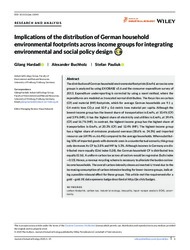Implications of the distribution of German household environmental footprints across income groups for integrating environmental and social policy design
DOI: https://doi.org/10.1111/jiec.13045
Persistent URL: http://resolver.sub.uni-goettingen.de/purl?gldocs-11858/9323
Persistent URL: http://resolver.sub.uni-goettingen.de/purl?gldocs-11858/9323
Hardadi, Gilang; Buchholz, Alexander; Pauliuk, Stefan, 2020: Implications of the distribution of German household environmental footprints across income groups for integrating environmental and social policy design . In: Journal of Industrial Ecology, DOI: 10.1111/jiec.13045.
 |
Dokument öffnen: |
The distribution of German household environmental footprints (EnvFs) across income groups is analyzed by using EXIOBASE v3.6 and the consumer expenditure survey of 2013. Expenditure underreporting is corrected by using a novel method, where the expenditures are modeled as truncated normal distribution. The focus lies on carbon (CF) and material (MF) footprints, which for average German households are 9.1 ± 0.4 metric tons CO2e and 10.9 ± 0.6 metric tons material per capita. Although the lowest-income group has the lowest share of transportation in EnvFs, at 10.4% (CF) and 3.9% (MF), it has the highest share of electricity and utilities in EnvFs, at 39.4% (CF) and 16.7% (MF). In contrast, the highest-income group has the highest share of transportation in EnvFs, at 20.3% (CF) and 12.4% (MF). The highest-income group has a higher share of emissions produced overseas (38.6% vs. 34.3%) and imported resource use (69.9% vs. 66.4%) compared to the average households. When substituting 50% of imported goods with domestic ones in a counterfactual scenario, this group only decreases its CF by 2.8% and MF by 5.3%. Although incomes in Germany are distributed more equally (Gini index 0.28), the German household CF is distributed less equally (0.16). A uniform carbon tax across all sectors would be regressive (Suits index −0.13). Hence, a revenue recycling scheme is necessary to alleviate the burden on low-income households. The overall carbon intensity shows an inverted-U trend due to the increasing consumption of carbon-intensive heating for lower-income groups, indicating a possible rebound effect for these groups. This article met the requirements for a gold – gold JIE data openness badge described at http://jie.click/badges.
Statistik:
ZugriffsstatistikSammlung:
Schlagworte:
carbon footprintcarbon tax
industrial ecology
inequality
input–output analysis (IOA)
uncertainty
This is an open access article under the terms of the Creative Commons Attribution License,which permits use, distribution and reproduction in any medium, provided the original work is properly cited.

